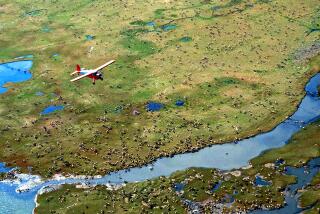Winter Nears, Yet Alaskans Smile: It’s Time for Annual Oil Dividend
- Share via
JUNEAU, Alaska — From stockbrokers to store managers, frugal ants to carefree grasshoppers, Alaskans love October.
Picture an entire state hunkering down for seven months of cold, dark winter, digging out down parkas and laying in a supply of firewood. Now picture a money-stuffed bomber flying overhead. Suddenly, a billion dollars flutters down onto the tundra.
What’s not to love?
OK, so there isn’t a plane. But the billion dollars is real. It comes in the form of 585,800 annual dividends from the Alaska Permanent Fund, a state account set up more than two decades ago to save part of the stream of taxes and royalties from the North Slope oil patch.
The dividend going out this month is a record $1,964, payable to every man, woman and child who has lived in Alaska for at least a calendar year. And regardless of how folks feel about Big Oil, nearly everybody who can do so takes the cash.
The money fuels an annual fall spending spree that’s become deeply entwined with Alaskan life and economics.
But how much of it gets spent? How much socked away for a rainy day? Does it go for Rolexes or rent, baby formula or the beach bars of Bali? Nobody really knows.
Consumers buy, and merchants certainly sell, but with no statewide sales tax, it’s difficult to even gauge the size of the spending boom. And no comprehensive study has ever tried to track the way the money gets spent, said Scott Goldsmith, an economics professor at the University of Alaska Anchorage.
“Some people go out and blow it, of course, but other people will invest it wisely,” Goldsmith said.
Anecdotes are plentiful: Giddy drunks buy rounds for the house until the money or the bottle runs dry. And families pool their dividends for a down-payment on a house.
Rural Alaskans buy the nets, boats, guns, fuel and ammunition they need to harvest enough fish and game to survive the winter. Parents in Anchorage buy shares of Intel with dreams of sending a newborn child to Stanford in 2018.
Collectors buy baseball cards, and kids of all ages buy toys ranging from Surfer Barbie to SUVs.
“Where do they blow it? They blow it right here,” said Jamie Miller, a manager at Boarderline, a snowboard shop in Juneau. “We love dividend time. A kid came in here the other day and spent, like, 1,200 bucks in one hour.”
Economists estimate that the dividend accounts for as much as 10 percent of the state’s economy.
“One can attribute a lot of the growth in the Alaskan economy in the last decade to the growing dividend,” Goldsmith said.
Like many other investors, the Permanent Fund got rich--very rich--in the booming stock market of recent years. It has grown from nearly $15 billion in 1995 to just under $28 billion, despite paying out roughly half its yearly earnings in dividends.
And the annual dividend, paid since 1982, has also grown rapidly over the same period. It has doubled since 1995. The 19 dividends distributed over the years add up to more than $18,500.
Competition for the money is intense. Newspapers bulge with advertising supplements and television commercials exploit the gathering dark of winter by touting the warm beaches of Hawaii and Mexico.
Much of the marketing focuses on big-ticket items such as pickups, snowmobiles, boats and hot tubs--merchandise suddenly available to a larger slice of the public.
“The dividend is so big for people with lower incomes, it gives them an opportunity that they might not otherwise have to make a payment on a big-ticket item,” Goldsmith said.
The market booms for things that fit nicely inside the dividend--travel, snowboards, bicycles, computers, appliances and furniture.
However, many dividends just disappear down the hungry throat of personal finance. Instead of paying for a single big extravagance, the money pays for a hundred little comforts throughout the year.
“We didn’t even see it. We got direct deposit, paid the bills and wished we had some more,” said Gerald Peterson of Hoonah, a predominantly Tlingit Indian town in southeast Alaska.
Peterson manages Hoonah’s city-owned liquor store. He says business picks up in October, but most of the new purchases he sees come in big cardboard boxes, not one-liter bottles.
“They buy a lot of household things, refrigerators and deep-freezes, couches and chairs,” Peterson said.
Thousands of dividend recipients never see their money. Child support deadbeats often have their dividends seized, as do student loan debtors. The Internal Revenue Service said this month that it will pursue the dividends of 10,500 Alaskans to recoup $15 million in back taxes.
Last year, with oil prices at record lows, some politicians started eyeing the fund. Gov. Tony Knowles and legislative leaders proposed diverting a few hundred dollars from each resident’s dividend to top off the treasury.
When they put the idea out for an advisory vote last year, they quickly found out how much Alaskans--who pay no state income or sales taxes--love their October windfall: 83 percent voted against the plan.
*
On the Net:
Alaska Permanent Fund:
https://www.apfc.org
More to Read
Sign up for Essential California
The most important California stories and recommendations in your inbox every morning.
You may occasionally receive promotional content from the Los Angeles Times.










